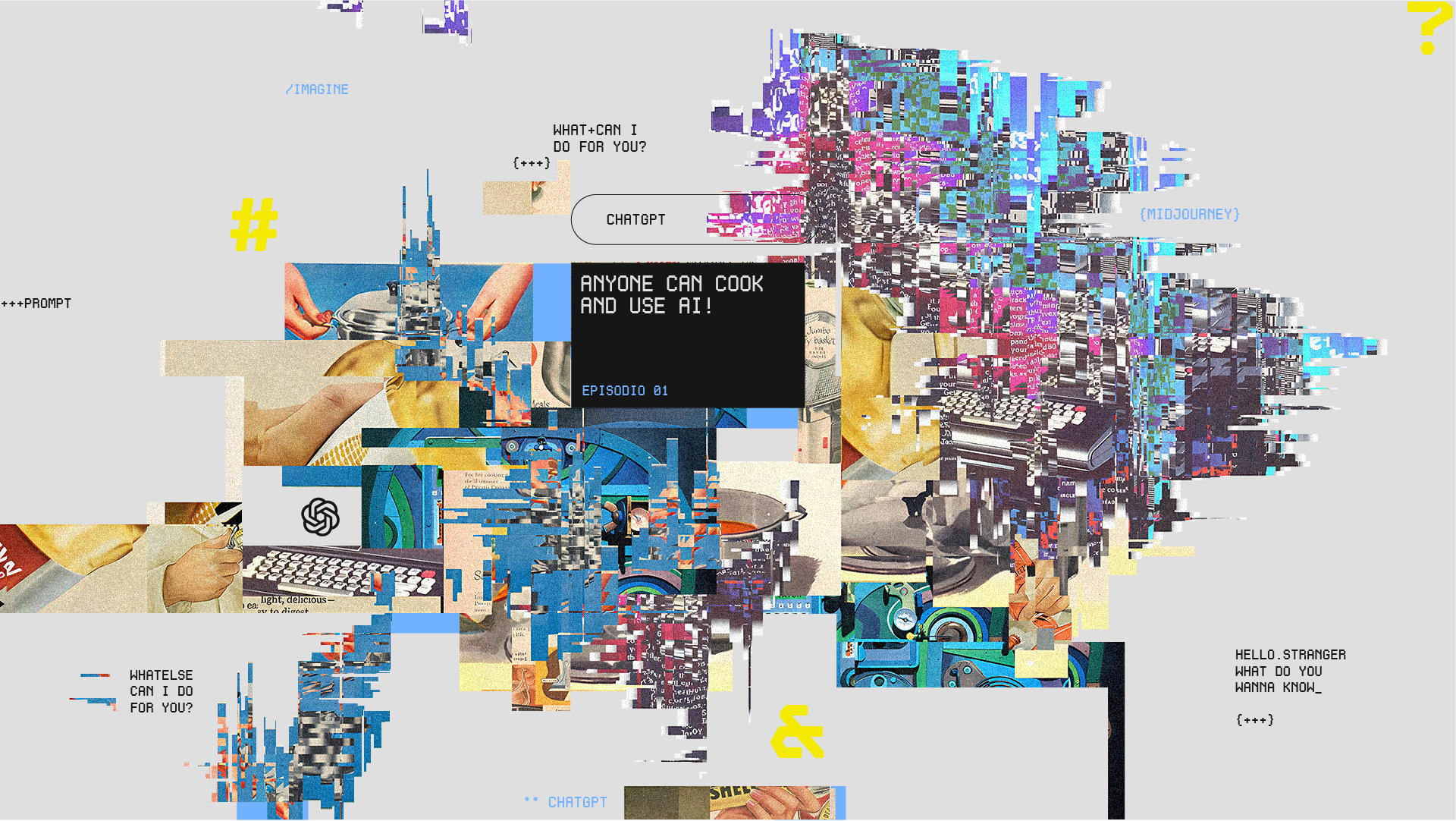Episode I: Anyone Can Cook, and Use AI!
AI: Argentine Intelligence. A Conversation about Artificial Intelligence
1 de Septiembre de 2023

Cover AI
The launch of ChatGPT will be remembered as one of the main milestones in the popularization of artificial intelligence (AI). This resulted in a kind of collective awareness in two senses: AI has a direct impact on all of us and is accessible to everyone.
The public discussion about AI and its implications, such as the type of information it uses, gets, and provides, its uses and applications, its consequences, and, naturally, its regulation, has accelerated and expanded, involving a larger number of participants. We, at the Co_Lab, the Accelerator Lab of UNDP Argentina, like many of you, have joined this conversation and would like to share what we are learning to better understand the challenges and opportunities of AI for the development of the Argentinians.
ChatGPT is an extremely user-friendly AI tool that can be used through a web interface similar to that of any chatbot. Just like Google's Bard or Microsoft's Bing AI that came after it, it can receive and understand a wide range of instructions, even in a colloquial fashion. Moreover, it provides results instantly. This made it attractive for all kinds of users and, within just 5 days, it reached a million users. This immediate adoption drew attention to its possibilities and risks, sparking different debates about its implications. |
It is Among Us
We might not know much about automotive mechanics, but we understand what a car is (and some of us even know how to drive). Similarly, we do not aim to know what happens within the “black box”" of AI, that is, how it executes our instructions to do the things we ask of it, but we do want to at least understand what it is. This is how we learned that AI is a field that combines computer science with information to simulate human intelligence. AI systems can mimic cognitive operations, such as recognizing objects and voices, generate text and images, or make recommendations, without needing precise instructions every time they do so. This is possible because they work with models that emulate the way people think and process information. In this sense, AI systems are said to be able to “learn.”
AI was already present in our lives: when you use Google's translator or voice assistant, when you did not even know you were about to break up with your partner, and Spotify was already suggesting a playlist called “Alone again,” when TikTok suggests things that are similar to what you had been viewing, or when hotels in Rio de Janeiro suddenly appear “out of the blue” on your IG after chatting with a friend on WhatsApp about a possible vacation to Brazil.

AI → Machine learning → Deep learning Deep learning, on the other hand, is a specific branch of machine learning inspired by the way the human brain works. It is based on the development and training of multi-layered artificial neural networks, and it is used to obtain highly accurate representations from raw data. In the previous example, deep learning would allow us to do away with human intervention in labeling the dog images, as the software would be capable of recognizing the distinctive patterns of each breed automatically. Deep learning has diverse applications, and significant advances have been made in areas such as facial recognition, where systems based on this technology can identify and verify individuals from images and videos. Additionally, natural language processing has improved thanks to deep learning models capable of understanding and generating text in different languages. Similarly, speech recognition has benefited from this technology, enabling the development of virtual assistants and more accurate transcription systems. In a nutshell, machine learning provides the foundations for training models using algorithms and structured data, while deep learning expands these capabilities by using neural networks to process unstructured data and obtain high-level representations, thus driving significant advances in various AI applications. |
Keeping these basic concepts in mind, we arrive at the “GPT” part in ChatGPT. This stands for Generative Pre-trained Transformer. What does it generate? Assisted by deep learning, this tool generates text. To do so, it was trained with a lot ‒and I mean a lot‒ of information to search for patterns, make predictions, and identify relationships in sequences of data, such as words in a sentence, but also to learn from context. “Essentially, it is a software program that can generate text by learning how text is formed through the study of large amounts of data which it then puts together based on the prompts it receives, using its knowledge to generate coherent text” (Conway 2023). The architecture of ChatGPT is based on a transformer neural network, which is a key technique in the field of deep learning.
The Ingredients of Your Recipe: Quantity and Quality of Information and Their Consequences
The quality and results of AI tools and applications depend on many variables. For starters, like any good cooking recipe, they depend on the ingredients AI works with. AI provides answers about probable outcomes based on the available information. If the information shows that, in the past, males were more likely to win Nobel Prizes or engage in science than females, when consulted, the AI’s predictions will go in that direction. Thus, we see that the quantity, quality, and type of information condition its results, i.e., cause them to be biased.
Algorithms are sequences of logical and mathematical instructions used to solve problems or perform specific tasks. In the context of computer science, they are used to process data and make decisions based on predefined rules, as they provide the framework and logic necessary for machines to perform smart tasks. |

If, based on biased information, algorithms, in turn, reproduce these patterns, AI will reinforce these asymmetries to the detriment of certain groups. This has happened when facial recognition tools lead the police to detain more people of color without criminal records than Caucasian people, as shown in the documentary “Coded Bias”. The proper choice and design of algorithms are fundamental to the development and success of artificial intelligence systems, especially to limit these kinds of biases.
Anyone Can Cook and Learn How to Use AI
Without a doubt, everything AI-related can be overwhelming and make us feel powerless in the face of so much information and uncertainty. We are all passive users of AI, and the opportunity lies in becoming active users, in putting these tools at our service.
Overcoming our fear and daring to take an active role in using the digital environments that employ AI tools is the advice that technologist Marcelo Rinesi gave in 2019. When we are passive users of AI, for instance, when using social media, the content algorithms show us can exacerbate our negative emotions, such as feelings of indignation and anger, as these emotions lead to a higher level of engagement and participation. Rinesi's alternative to this is to shift from that passive role to an active one. That is, to leverage any of the thousands of available AI tools and put them at our service in our work and personal lives.
AI can work to our advantage not only at the individual level; but rather, nowadays, governments and organizations have the opportunity to use many of these available tools that could result in higher levels of productivity and better services for citizens at a cost that is more than accessible. This is what Rinesi suggests in a podcast. He also indicates that developing AI tools is extremely costly, which will lead to important asymmetries between those in the private sector who can gather the necessary investments to do so and/or countries that can strategically finance it, and those who cannot. However, today there are still many IA tools available that can be used. According to this expert, the barriers to their adoption are psychological and cultural because, in addition to not being expensive, their use is accessible, even if the support of experts is needed to adapt them.
In different countries, specific regulations on AI are being developed. Attention is being drawn to the specific challenges of our region. In the case of Argentina, in 2019, a national artificial intelligence strategy was published and, more recently, also a guide on how to use AI in public administration.
To sum up...
AI has brought about a revolution in our society, arousing curiosity and the need to understand its implications. As we delve into this world, it is essential to be informed and aware of the challenges and opportunities it presents, and UNDP Argentina wants to be part of this conversation. The unintended consequences of AI use can be serious, such as biased results and the reproduction of asymmetries or stereotypes; hence, the need for governments and other organizations to engage in the regulation and prevention of these phenomena. Beyond these dangers, and although AI can have significant limitations and raise concerns, it also offers great possibilities to improve our lives and enhance the development of our communities. The key is to overcome our fear and take an active role in the adoption and responsible use of AI tools.
We are all passive users of AI, and the opportunity lies in becoming active users, in putting these tools at our service.Lorena Moscovich

 Locations
Locations




